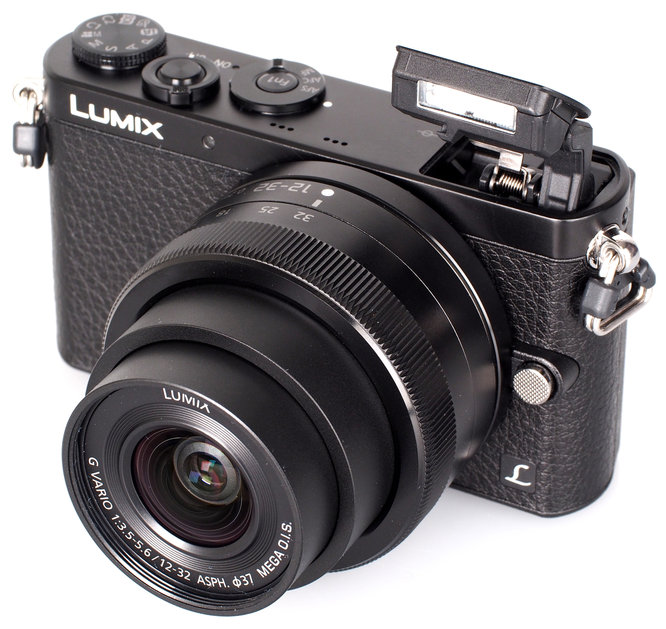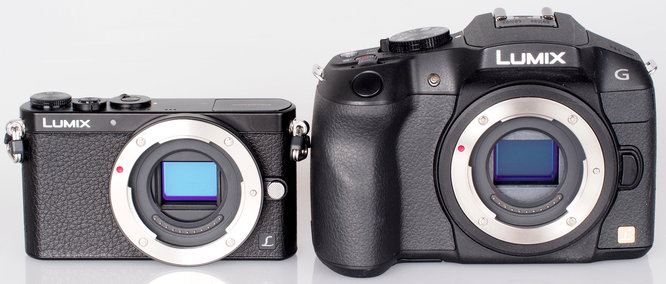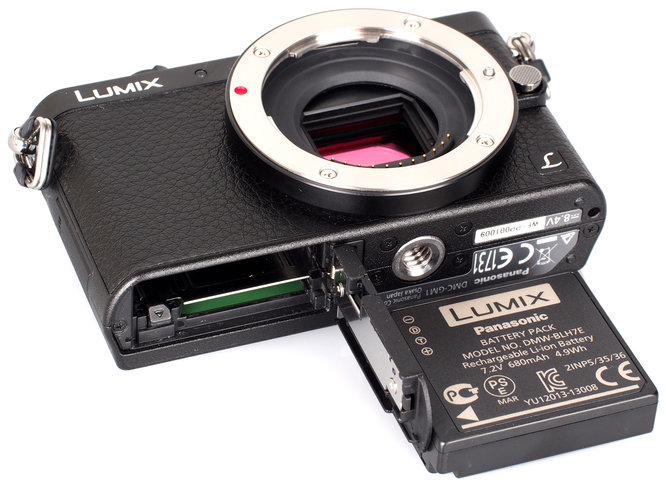It's barely bigger
than a pack of cards, but the Lumix GM1 may well be
the perfect pocketable CSC.

Panasonic Lumix GM1 Review
Panasonic sought inspiration from its premium GX7 before
developing the GM1 and despite being significantly smaller, it inherits many of
the GX7's innards, including the same 16MP Live MOS sensor with a 4592 x 3448
pixel output and standard sensitivity range of 200-25,600, which is extendable
to an equivalent of ISO 125. Processing power comes from Panasonic's Venus
processing engine and it also inherits Panasonic's tried-and-tested Light Speed
AF system which has a sensor data read-out time of 240fps and focus speeds of
around 0.06sec.

Panasonic Lumix GM1 next to the Panasonic Lumix
G6
In addition, those who shoot in low light will appreciate
the GM1's -4EV detection range (roughly equivalent to starlight), while there's
also the Pin-Point AF mode that allows you to precisely select the area of
focus within a magnified view. On the subject of the screen, it has a 3in,
1036k-dot display that supports touch functionality. An impressive shutter
speed range (60-16000sec) will appeal, but the feature it lacks is a
viewfinder. There is a small pop-up flash and the GM1 can shoot at up to 5fps
set to its AF-S mode with its mechanical shutter, or up to a sprightly 40fps
once the electronic shutter is enabled. Despite its dinky proportions it also
has Wi-fi to enable wireless image transfer to
smartphones or tablets, with remote control available. Full HD video (1920 x
1080) is supported but there's no 3.5mm mic port.
The durable magnesium alloy construction and faux-leather
frontage puts it in a higher league of finish compared to its Lumix cousin, the GF6. The compromise for it being so small
however is the lack of command dials to control aperture and shutter speed
independently, but the touchscreen can be used to alter most settings. There's
no handgrip to wrap your fingers around, and while this preserves the
minimalist styling, it wouldn't have gone amiss.
Whereas most CSCs can shoot more than 300 frames before a
recharge is required, the GM1 has a battery life of 220 images. Given that USB
charging isn't supported either, this conservative battery life is rather
disappointing. It's a camera that really impresses when it comes to focusing,
locking onto targets in a blink of an eye and rarely hesitating in low light.
Having the option to pin-point, reposition and resize the AF point so
intuitively via the touchscreen also means you can focus and shoot incredibly
quickly.
The Micro Four Thirds chip can resolve strong levels of
detail (24 lpmm) up to ISO 800, beyond which detail
starts to tail off. Luminance noise gets progressively pronounced at ISO 1600
and 3200, with finer detail becoming harder to distinguish at ISO 6400 and
beyond. Straight out of the camera, images appear vibrant, but there is the
option to enhance saturation and vibrancy with up to seven photo styles and in
scenes where there's stark contrast, the GM1's i. Dynamic
mode is handy for retaining a little extra detail in the shadows.

Battery life is
rated at 230 shots according to Panasonic / CIPA test results
Verdict
The way such impressive features have been squeezed into
such a small body goes to show what is possible, and as well as the GM1 being a
great technological achievement in its own right, Panasonic has put its own
stamp on what we define as compact in Compact System Camera. The limited
battery life is the only underlying concern.
Key specs ·
Sensor: 16MP (Four Thirds type) ·
File formats: Raw, JPEG, Raw + JPEG, MPO ·
Shutter speeds: 60-1/16000sec ·
ISO: 200-25,600 ·
Exposure modes: Auto, PASM ·
Movie mode: 1920x1080, 50i ·
Display: 3in touchscreen LCD, 1,036k-dots ·
Viewfinder: No ·
AF points: 23 ·
Built-in flash: No ·
Memory card: SD, SDHC, SDXC ·
Power: Rechargeable Li-ion battery ·
Dimensions: 99 x 55 x 30mm ·
Weight: 204g (including battery and card) Best for ·
Full manual control ·
Those after pocketability
with the versatility of interchangeable lenses ·
Stepping up from a point and shoot Alternatives ·
Panasonic Lumix
DMC-GX7 $1,492.74 ·
Sony Cyber-shot RX100 II $1,078.09 ·
Pentax Q7 $663.44 Pros ·
Solid chassis ·
High-end finish ·
Wi-fi connectivity ·
Touchscreen functionality ·
Pin-point AF Cons ·
Lacking a viewfinder ·
Lack of handgrip ·
Poor battery life ·
No headphone port ·
USB charging not permitted
|